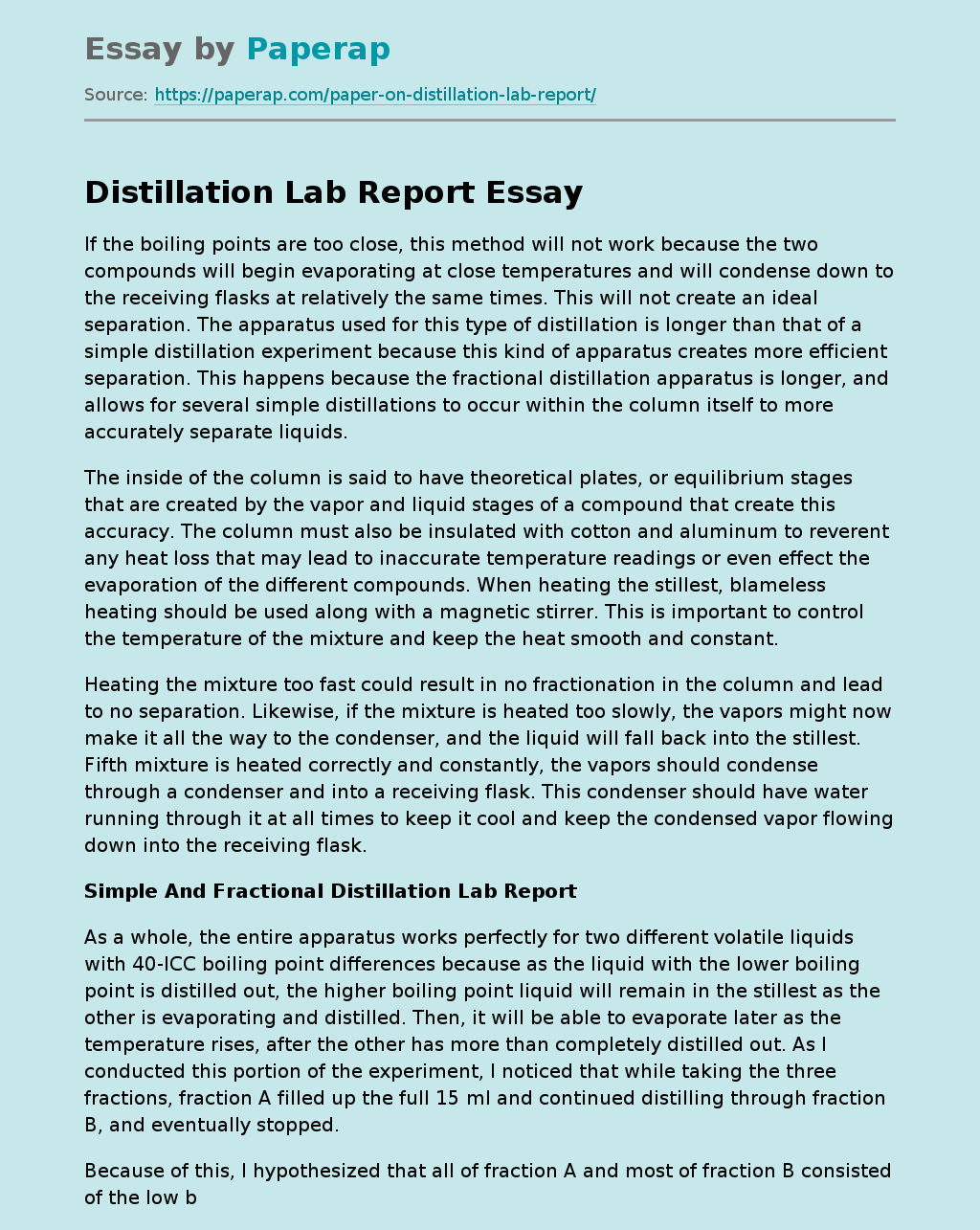Distillation Lab Report
If the boiling points are too close, this method will not work because the two compounds will begin evaporating at close temperatures and will condense down to the receiving flasks at relatively the same times. This will not create an ideal separation. The apparatus used for this type of distillation is longer than that of a simple distillation experiment because this kind of apparatus creates more efficient separation. This happens because the fractional distillation apparatus is longer, and allows for several simple distillations to occur within the column itself to more accurately separate liquids.
The inside of the column is said to have theoretical plates, or equilibrium stages that are created by the vapor and liquid stages of a compound that create this accuracy. The column must also be insulated with cotton and aluminum to reverent any heat loss that may lead to inaccurate temperature readings or even effect the evaporation of the different compounds. When heating the stillest, blameless heating should be used along with a magnetic stirrer.
This is important to control the temperature of the mixture and keep the heat smooth and constant.
Heating the mixture too fast could result in no fractionation in the column and lead to no separation. Likewise, if the mixture is heated too slowly, the vapors might now make it all the way to the condenser, and the liquid will fall back into the stillest. Fifth mixture is heated correctly and constantly, the vapors should condense through a condenser and into a receiving flask.
This condenser should have water running through it at all times to keep it cool and keep the condensed vapor flowing down into the receiving flask.
Simple And Fractional Distillation Lab Report
As a whole, the entire apparatus works perfectly for two different volatile liquids with 40-ICC boiling point differences because as the liquid with the lower boiling point is distilled out, the higher boiling point liquid will remain in the stillest as the other is evaporating and distilled. Then, it will be able to evaporate later as the temperature rises, after the other has more than completely distilled out. As I conducted this portion of the experiment, I noticed that while taking the three fractions, fraction A filled up the full 15 ml and continued distilling through fraction B, and eventually stopped.
Because of this, I hypothesized that all of fraction A and most of fraction B consisted of the low boiling point compound. As I raised the temperature of the hotplate, I was able to collect fraction C, and I predicted that it was composed of mostly the high boiling point liquid. To test this, the experiment called for the use of gas chromatography. The chromatography would not only show the relative concentrations of each impound in the fraction, but could also help confirm the identification of the compounds we thought were in the fractions based on the temperatures that each liquid boiled.
Before trying to guess the correct compounds of the mixture, one must run each individual fraction through the machine to clearly see the composition of each. Gas chromatography works because as the liquid runs through the machine, its different components run through and exit at different times due to changes of temperatures that measure high and low boiling points. The machine records these using peaks of retention time that identify these different components. After obtaining this data, there was enough information to choose a reasonable match for each of the components.
Once both the fractions and the guessed compound were mixed, the retention recordings should not differ in the number of peaks because ideally the compound mixed should have the same retention time as one of the other previous peaks. If the compounds were to differ in the number of peaks, then it shows that another compound must be present with different properties. As I conducted this portion of the experiment, guessed cyclopean for my low boiling point liquid and toluene or heptanes for my high boiling point squid based on the fractional distillation observations.
For cyclopean I mixed it with fraction A, since it predominantly consisted of my low boiling point liquid, and observed two peaks in my results. Therefore I concluded that cyclopean was the low boiling point liquid. However, for the second liquid I guessed heptanes first, and my results showed three peaks. Knowing that I had guessed wrong, I tested toluene mixed with my fraction C and only got two peaks. The high boiling point liquid proved to be toluene. In conclusion, my results all matched the main ideas and theories presented in the experiment.
Distillation Lab Report. (2019, Dec 05). Retrieved from https://paperap.com/paper-on-distillation-lab-report/

